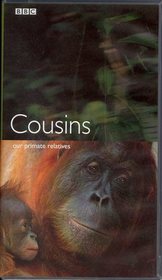Cousins (TV series)
| Cousins | |
|---|---|

VHS cover art
|
|
| Genre | Nature documentary |
| Presented by | Charlotte Uhlenbroek |
| Composer(s) | Guy Michelmore |
| Country of origin | United Kingdom |
| Original language(s) | English |
| No. of episodes | 3 |
| Production | |
| Producer(s) | Bernard Walton |
| Running time | 50 minutes |
| Production company(s) |
BBC Natural History Unit Discovery Channel |
| Release | |
| Original network | BBC One |
| Picture format | SD: 4:3 |
| Audio format | Stereo |
| Original release | 16 August – 30 August 2000 |
| External links | |
| Website | www |
Cousins is a nature documentary TV series produced by the BBC Natural History Unit in Bristol, England, first transmitted in the UK on BBC One in August 2000. The series looks at the primates, the closest living relatives to human beings.
The series marked the debut as a television presenter of Charlotte Uhlenbroek, a 32-year-old primatologist who had worked with Jane Goodall at Gombe Stream studying chimpanzee behaviour. Over the course of the three, 50 minute episodes, Uhlenbroek encounters many species of primate, from the lemurs of Madagascar to the mountain gorillas of Rwanda. The animal behaviour filmed is used to explain the origins of primates and the development of skills and adaptations that have enabled human beings to become the most successful primate of all.
Filming took place on three continents. Some of the difficulties encountered by the filmmakers in Madagascar when filming black-and-white ruffed lemurs included leeches and swaying platforms in the canopy, whilst in China, the crew had to form a protective ring around the cameraman to protect against muggings by Tibetan macaques. The series producer was Bernard Walton.
Featured prosimian species:
Uhlenbroek begins the series in Africa, observing a group of chimpanzees in the West African forest. In the Virunga Mountains of Rwanda she gets her first close encounter with a group of mountain gorillas. Like the chimps, they are descended from a common ancestor, similar to the pygmy mouse lemur found today in Madagascar's dry forests. It is a prosimian, a group of primates which are largely nocturnal, forced to hunt and feed at night by the more successful monkeys and apes. In common with all primates they have forward-facing eyes and grasping hands. Other prosimians shown include Mohol bushbabies and South East Asia's slow lorises and tarsiers. The larger primates never reached Madagascar, making the island a sanctuary for prosimians, especially lemurs. Uhlenbroek watches Verreaux's sifakas feeding in didiera trees, then travels to the reed beds around Madagascar's largest lake to track the rare and elusive bandro. Greater bamboo lemurs are filmed for the first time. The limestone karst landscape of north Madagascar is home to crowned lemurs, and under the cliffs is a 40 km long labyrinth of caves where giant fossilised lemurs have been discovered. Brown lemurs are shown eluding their main predators, a Madagascan harrier-hawk and a fossa. The aye-aye is a nocturnal specialist filmed extracting a grub with its spindly middle finger. The programme ends with a sequence on ring-tailed lemurs which form larger communities and spend more time on the ground than other lemurs. They have strictly hierarchical societies led by the females, who will even attack intruders as their babies cling to their backs.
...
Wikipedia
